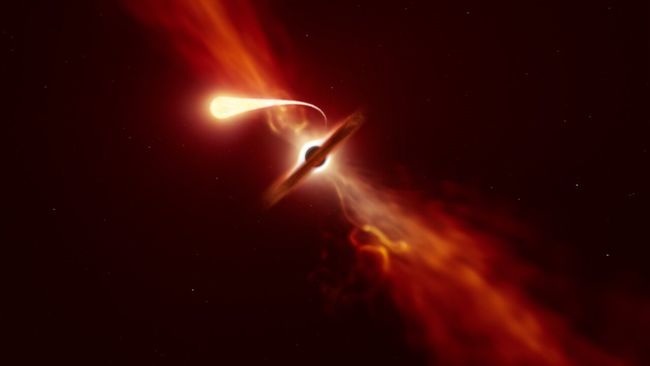The discovery more than doubles the number of known black hole tidal disruptions detected in the local universe
MIT astronomers have discovered 18 hitherto unknown black holes that are actively «tearing» and «devour» stars. This discovery is already changing our understanding of the Universe, doubling the number of tidal disruption events (TDEs) observed in the local Universe. The discovery of these black holes will help astronomers more accurately estimate the number of such events in the Universe and get closer to theoretical models.
This destruction of stars, called tidal disruption, occurs when a star gets too close to a black hole and the gravitational influence creates enormous tidal forces in the star. As a result of this impact, the star is stretched in the vertical direction and compressed in the horizontal direction; this process is called “spaghettification”. In this case, the star's material forms a disk around the black hole, part of this material is absorbed by the black hole, while the other part is «splashed out» in the form of jets accelerating at a speed close to light.
Previously, it was believed that black holes are capable of tearing apart and absorbing stars only in galaxies that have recently gone through an active period of star formation. But this study demonstrates that TDE processes can occur in a wider range of galaxies, which has important implications for explaining some of the extreme phenomena observed around black holes.
Erin Kara, assistant professor of physics at MIT, notes that for a long time, scientists have proposed the most exotic ideas to explain these mysteries, but now the moment has come when it is possible to have all the answers.
An MIT team began searching for new star-tearing black holes after detecting the closest TDE event to Earth, which was seen in the galaxy NGC 7392, located about 137 million light-years from Earth.
Scientists have developed an algorithm that has detected bursts of radiation associated with TDE based on infrared data. Using this algorithm and data from NASA's NEOWISE satellite, astronomers were able to identify the spectra of more than 1,000 galaxies within 600 million light years of Earth.
By analyzing this data and comparing it with the characteristics of TDEs and other phenomena such as supernovae, scientists were able to confirm 18 cases of TDE events caused by the influence of the gravity of black holes, resulting in the death of a star.
The team also found that star destruction events occur not only in rare galaxies after star formation has ended, but also in other types of galaxies. As it turned out, such events occur even in those galaxies that are filled with dense clouds of dust.
«If you look at the sky and see a group of galaxies, TDEs will be characteristic of all of them», — said lead study author and graduate student at MIT's Kavli Institute for Astrophysics and Space Research Megan Masterson.
TDE was previously thought to be limited to galaxies in the post-star formation stage. However, this study dispels this belief and shows that such events occur in different types of galaxies. The question was why TDEs only occur in some galaxies while they are absent in others. The answer to this question lies in the presence of dense clouds of dust in galaxies. Gas and dust can absorb optical and x-ray radiation, but infrared radiation penetrates matter. Previously, TDE observations were only possible using X-rays and optical radiation. This study showed that infrared radiation must also be used to detect star-destroying black holes.
Adding 18 new TDE observations to previously known TDE events allowed scientists to determine that galaxies experience such events approximately once every 50,000 years, which is consistent with previous theoretical predictions.
«This gives us confidence that we don't need exotic physics to explain what we see»,— Kara concluded.

